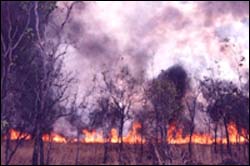Arid Australian interior linked to landscape burning by ancient humans

The image of a controlled burn in the interior of Australia today, featured on the cover of the January 2005 issue of Geology, illustrates how Australia might have looked 50,000 years ago. Photo courtesy Gifford Miller, University of Colorado at Boulder
Landscape burning by ancient hunters and gatherers may have triggered the failure of the annual Australian Monsoon some 12,000 years ago, resulting in the desertification of the country’s interior that is evident today, according to a new study.
University of Colorado at Boulder Professor Gifford Miller said the study builds on his research group’s previous findings that dozens of giant animal species went extinct in Australia roughly 50,000 years ago due to ecosystem changes caused by human burning. The new study indicates such burning may have altered the flora enough to decrease the exchange of water vapor between the biosphere and atmosphere, causing the failure of the Australian Monsoon over the interior.
“The question is whether localized burning 50,000 years ago could have had a continental-scale effect,” said Miller, a fellow at CU-Boulder’s Institute of Arctic and Alpine Research. “The implications are that the burning practices of early humans may have changed the climate of the Australian continent by weakening the penetration of monsoon moisture into the interior.”
A paper on the subject by Miller appears in the January issue of Geology. Co-authors include CU-Boulder’s Jennifer Mangan, David Pollard, Starley Thompson and Benjamin Felzer of the National Center for Atmospheric Research in Boulder and John Magee of Australian National University in Canberra.
Geologic evidence indicates the interior of Australia was much wetter about 125,000 years ago during the last interglacial period. Although planetary and meteorological conditions during the most recent ice age caused Earth’s major monsoons to waver, all except the Australian Monsoon were “reinvigorated” to full force during the Holocene Period beginning about 12,000 years ago, he said.
Although the Australian Monsoon delivers about 39 inches of rain annually to the north coast as it moves south from Asia, only about 13 inches of rain now falls on the continent’s interior each year, said Miller, also a CU-Boulder geological sciences professor. Lake Eyre, a deep-water lake in the continent’s interior that was filled by regular monsoon rains about 60,000 years ago, is now a huge salt flat that is occasionally covered by a thin layer of salty water.
The earliest human colonizers are believed to have arrived in Australia by sea from Indonesia about 50,000 years ago, using fire as a tool to hunt, clear paths, signal each other and promote the growth of certain plants, he said. Fossil remains of browse-dependent birds and marsupials indicate the interior was made up of trees, shrubs and grasses rather than the desert scrub environment present today.
The researchers used global climate model simulations to evaluate the atmospheric and meteorological conditions in Australia over time, as well as the sensitivity of the monsoon to different vegetation and soil types. A climate model simulating a forested Australia produced twice as much annual monsoon precipitation over the continental interior as the model simulating arid scrub conditions, he said.
“Systematic burning across the semiarid zone, where nutrients are the lowest of any continental region, may have been responsible for the rapid transformation of a drought-tolerant ecosystem high in broad-leaf species to the modern desert scrub,” he said. “In the process, vegetation feedbacks promoting the penetration of monsoon moisture into the continental interior would have been disrupted.”
More than 85 percent of Australia’s megafauna weighing more than 100 pounds went extinct roughly 50,000 years ago, including an ostrich-sized bird, 19 species of marsupials, a 25-foot-long lizard and a Volkswagen-sized tortoise, he said.
Evidence for burning includes increased charcoal deposits preserved in lake sediments at the boundary between rainforest and interior desert beginning about 50,000 years ago, Miller said. In addition, a number of rainforest gymnosperms — plants whose seeds are not encased and protected and are therefore more vulnerable to fire — went extinct at about that time.
Natural fires resulting from summer lightning strikes have played an integral part in the ecology of Australia’s interior, and many plant species are adapted to regimes of frequent fires, he said. “But the systematic burning of the interior by the earliest colonizers differed enough from the natural fire cycle that key ecosystems may have been pushed past a threshold from which they could not recover.”
Media Contact
More Information:
http://www.colorado.eduAll latest news from the category: Ecology, The Environment and Conservation
This complex theme deals primarily with interactions between organisms and the environmental factors that impact them, but to a greater extent between individual inanimate environmental factors.
innovations-report offers informative reports and articles on topics such as climate protection, landscape conservation, ecological systems, wildlife and nature parks and ecosystem efficiency and balance.
Newest articles

Silicon Carbide Innovation Alliance to drive industrial-scale semiconductor work
Known for its ability to withstand extreme environments and high voltages, silicon carbide (SiC) is a semiconducting material made up of silicon and carbon atoms arranged into crystals that is…

New SPECT/CT technique shows impressive biomarker identification
…offers increased access for prostate cancer patients. A novel SPECT/CT acquisition method can accurately detect radiopharmaceutical biodistribution in a convenient manner for prostate cancer patients, opening the door for more…

How 3D printers can give robots a soft touch
Soft skin coverings and touch sensors have emerged as a promising feature for robots that are both safer and more intuitive for human interaction, but they are expensive and difficult…





















